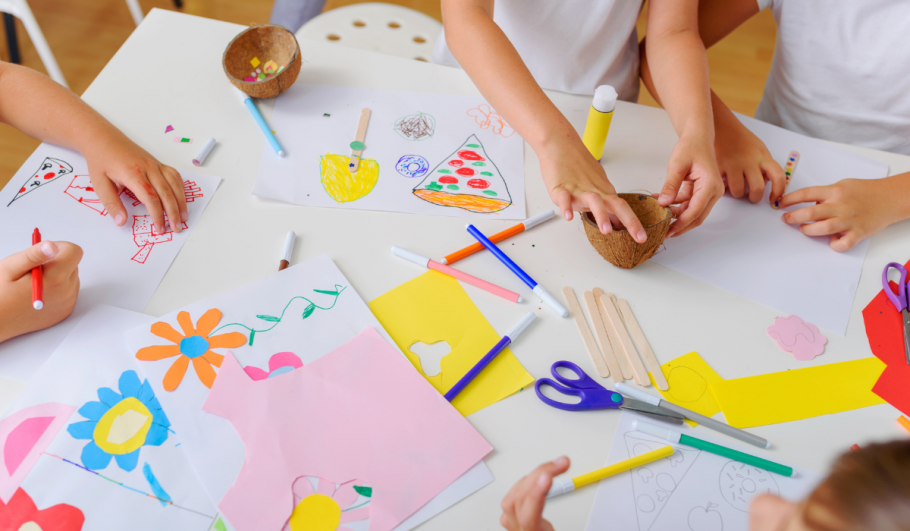Last Updated on August 29, 2024
The IELTS speaking section is made up of three important parts, of which the Cue Card one is often the most challenging bit. The cue card section of IELTS requires candidates to speak to the examiner for 2-3 minutes on any randomly given topic. This section thoroughly assesses your ability to communicate in English. Ace your prep with Admissify as we explore the cue card “describe an arts and crafts activity that you had at school.”
Example 1: Describe An Arts And Crafts Activity that You Had at School
Introduction
Art makes life easier and encourages the development of creative skills. Without art, our lifestyle would be like a black-and-white photograph, and we also start many endeavours with the help of art.
What did you make?
Here I want to discuss calligraphy, the art of decorative and elegant writing I learned in school.
How did you make it? And What does it look like?
It was during the summer vacations, while I was in fifth grade, my school organized a summer camp. My parents put me in writing classes because of my terrible handwriting. I had a hard time going to classes for a few days because I wanted to enjoy my summer vacation. Still, eventually, some of my classmates joined me, and I became interested in cursive writing.
It was difficult for me to switch writing classes, but the teacher was patient. She boosted my confidence and helped me recognize the importance of beautiful handwriting, which is valuable not only for academic purposes but also for many other contexts.
She reminded me that with this skill, we could make greeting cards and gifts for loved ones and gain an appreciation for different art forms. My teacher gave me a couple of notebooks with alphabets with dots to practice and properly follow the shape. In just two weeks, I could write fluently with very attractive handwriting, and both my parents and friends were amazed to see that I was writing aesthetically rather than scribbling.
And how do you feel about the activity?
I also made many posters with encouraging phrases written in cursive and put them up in my study space.
Conclusion
I must say it is a crucial art form every youngster needs to master to be creative and artistic.
Example 2: Describe An Arts And Crafts Activity that You Had at School
Introduction
So many events at my school are related to arts and crafts, and now I’d like to tell you about one such event in which most students participated, which also broke some records and was a great asset to our school: the drawing competition.
What did you make?
I drew a painting. Our sixth-grade teacher gave us an assignment during the summer break. The assignment was to make a landscape painting.
How did you make it? And What does it look like?
Since I had a lot of time, I did a lot of research to choose the right subject for my painting.
In the end, I decided to paint the Ganges River with the Himalayas in the background. To accurately depict nature on canvas, one must be precise with the use of color. The painting took one week to complete. At first, I was quite anxious, but I soon got into the flow. Starting on the third day, I began to enjoy every moment of my work. It was neatly drawn by me. I had to mix various hues to get the desired background colour. When I unveiled the work to the school, I finally got appreciation from the school. They applauded me enthusiastically. I got a trophy and a bouquet of peonies from the school principal.
And how do you feel about the activity?
That day, I was on cloud nine since that event changed the course of my life and made me a more confident person. After that, I participated in many more competitions, bringing honours to my school.
Conclusion
The admiration I had gotten on that particular day would be etched in my memory forever, and it filled me with immense pride.
Example 3: Describe An Arts And Crafts Activity that You Had at School
Introduction
As a young schoolboy, I enjoyed many aspects of my primary school, like playing with friends in the schoolyard and sharing lunch with them. However, there was another aspect of my elementary school that I enjoyed immensely: the periodic arts and crafts sessions. Today, I would like to describe an elementary school activity I participated in.
What did you make?
In this particular art and craft activity, cardboard was used to make “photo albums.” Initially, I was not particularly interested in art or craft activities since I simply did not enjoy them as much as I did for other school activities. Possibly since I was doing it alone, I did not like it as much as I would have liked. Later, when our school got a new art teacher, he realised the issue and chose to group children like us to force us to collaborate. Anyway, it is time to return to the past and describe my primary school “photo album.”
How did you make it? And What does it look like?
I used some sturdy cardboard, some photo magnet papers, a hole puncher, and some thick binding cords to create this album. First, I cut two sheets of sturdy cardboard to the same size and shape. Then, I trimmed as many sheets of photo magnet paper to the same proportions as the cardboard covers as I desired. I simply attached or adhered the photo magnet papers to the cardboard to stack them in layers. I punched two holes along one side of the stacked layers so that I could thread the cord binders through the punched holes to bind the layers together.
And how do you feel about the activity?
Regardless, I felt great about this specific art and craft project since I could see the results of my labour. In addition, this activity allowed me to share some laughs and quality time with other students, which would not have been possible otherwise.
Conclusion
Finally, due to this exercise, I discovered my hobby. I still cherish the project a lot as I got the opportunity to make friends for life while also being able to showcase how creative I am.
Other IELTS Cue Card:
Describe A Resolution You Made In The New Year
Describe Something Important That You Lost
Describe A Time When You Needed To Use Your Imagination
Follow Up Questions: Describe An Arts And Crafts Activity that You Had at School
1. What types of traditional handicrafts exist in your country?
My country is blessed with many traditional handicrafts. Punjab is known for its Phulkari, Kashmir is renowned for carpet weaving, and Rajasthan is famous for its ceramic pottery. Since my country is so diverse, the traditional handicrafts are also varied.
2. What are the benefits of creating handicrafts?
Yes, undoubtedly. Art promotes children’s creativity. It nurtures their imagination. Additionally, it provides a break from the rigorous academic curriculum. It adds variety to their lives. Moreover, adults can easily manage stress through it.
3. Why do some people think art is difficult to understand?
Firstly, art is interpreted differently by different people, which is rarely acknowledged. Secondly, everyone’s interests are unique. Some find folk music highly enjoyable, while others prefer contemporary music.
Unlike other forms of entertainment, in only a few cases does art provide instant gratification. To derive meaning from a work of art, one needs a certain aesthetic sense. This makes art challenging for most people to comprehend.
4. What can we do to make young people pay more attention to traditional art?
We can organize traditional art youth events. When teenagers compete in them, their interest will be aroused. Educators can also pique students’ curiosity by showcasing such art through audiovisual means. The media can air programs complemented by traditional art. Parents should ensure all family gatherings and festivals are celebrated in an engaging, traditional way.
5. Do you think it’s important to nurture an appreciation for art in children?
Yes, it is vital to do so. Art provides children with an enjoyable approach to learning. They cultivate their creativity and imagination. Moreover, an appreciation of art helps us learn about the culture and customs of diverse nations.
6. Do you think art should be included in school curriculums? Why?
Yes, art should be mandated in school curriculums because it gives children much-needed respite. It enhances students’ creativity and encourages them to think outside the box to lead lives on an exceptional growth trajectory.
7. Have you attended any lessons about art?
Yes, there was an art class at my school. We learned how to draw and paint during that time. There were also art and dance classes where we could discover our talents.
8. What have you learned from these lessons?
The most important lesson I have learned is that mastery in any profession can be attained through consistent, determined, and disciplined work.
9. What do young people think of traditional handicrafts?
I believe most young people appreciate traditional handicrafts. However, I also think young people lack the patience to create these traditional handicrafts like a few decades ago. Still, this handicraft reflected the customs and culture of the era it was made.
10. Do people in your country send handicrafts as gifts?
I think most people lack the time to make handicrafts. So it has become less common. But many elderly people give handicraft gifts. For example, whenever my brother visits friends, he makes greeting cards to express his affection.
11. What art activities did your school offer, and how did they benefit students?
Numerous arts and crafts activities were offered, including drawing, painting, playdough modeling, and symmetry painting, among others. These exercises help children develop their creativity and relieve the mental strain of academics. Additionally, students may uncover their genuine talent and cultivate it further.

Manan is a graduate of the esteemed University of Delhi where he cultivated a taste for writing and research. His degree in Bachelor of Management Studies helps him guide students in their academic endeavours. Manan strives to spread excellent study abroad tips that can prove to be helpful.




